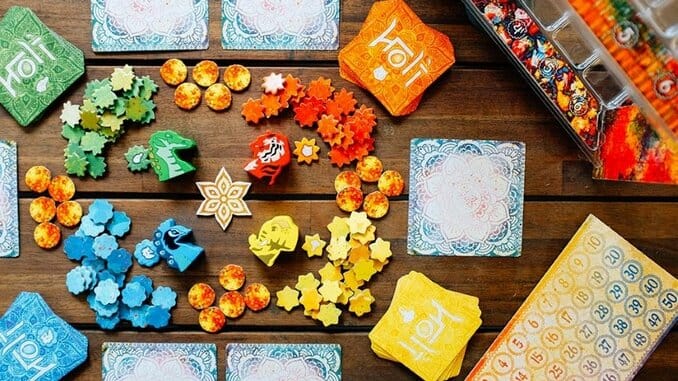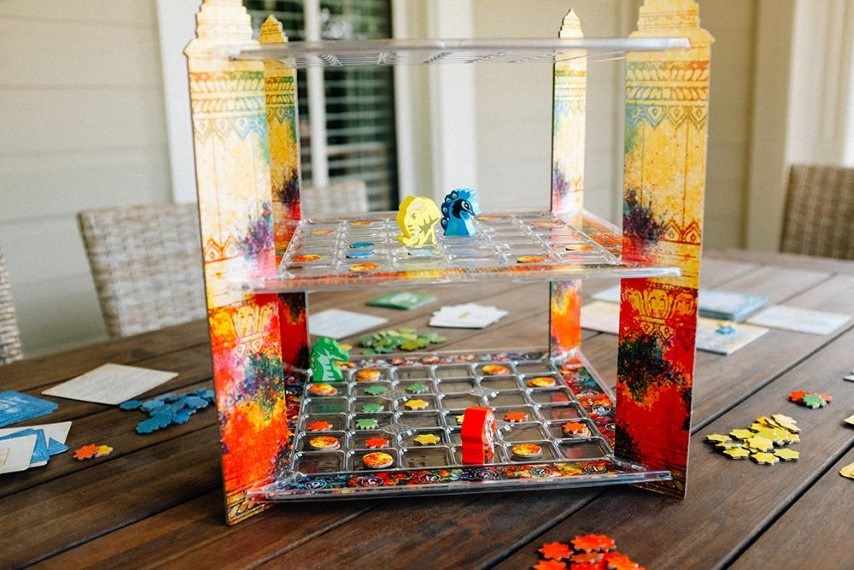Holi Is a Beautiful Board Game That Prioritizes Strategy Over Luck
Images courtesy of Floodgate Games Games Reviews board games
We’ve already had several new game releases this winter that stand out for their incredible visuals—Canvas, which I reviewed two weeks ago, has some of the best art I’ve ever seen on a game, while Cloud City has a great 3-D concept that fell flat in game play. Holi, the newest release from Floodgate Games, takes 3-D even further, with a three-tiered board that might remind you a bit of 3-D chess, and an explosion of color that draws inspiration from the Hindu festival by that name that begins at the end of this month. It’s a surprisingly rich game for its short rule set, and the lack of any real random elements means your skill in playing your cards and moving your token will determine whether you win.
Holi’s board is a showstopper: it has three levels of clear plastic trays with grids in which you can place player tokens, sweets, and flowers during the game, held up by four cardboard pieces at the corners. Players start on the corner spaces of the bottom tray, and over the course of the game will play cards from their hands to ‘throw’ flowers in designated patterns on the tray where their tokens stand. They’ll also have the chance to climb to higher levels, with flowers of your color worth more points the higher they sit when the game ends. There’s a catch, of course: when you throw flowers on to spaces with nothing below them, the flowers will fall ‘through’ the tray (not literally) to the one below, and perhaps all the way to the bottom. There are 16 sweets tokens on the bottom two levels, which you can collect while moving your player token to try to get a game-end bonus.
Each player has their own player token and a pile of flowers in their specific color. On a turn, they’ll play one of the aforementioned color cards with a pattern showing a 3×3 grid with three squares filled in with their specific color. Some cards also show a symbol for their player token in a fourth square on the grid. If the card does show that, the player must place their own flower tokens in that pattern on the level where their player token sits, and the pattern must include the space with their player token on it shown on the card. If the card doesn’t show the token symbol, then the player’s token must take one of the three colored spaces on the card, with flowers going into the other two.
This is simple enough when the game starts, but once flowers are out there, your options narrow, because you can’t place one of your flowers on a space with another flower—yours or anyone else’s—on it. You can throw a flower to a space holding another player’s token, which scores you one point for a Direct Hit, and then lets you place your flower in the other player’s supply for another two points at game end. (If you throw a flower into a space above another player’s token, so that it would fall through on to them, you don’t get the first bonus but still place your flower in their supply.) There are two ways to avoid a situation where you can’t make a legal play, which would force you out of the game. You can skip the color pattern and place a single flower anywhere on your level of the board, although you can’t do this on consecutive turns. And you have an optional action on every turn to move your player token to any space on your level, thus setting up a possible move for the subsequent turn. If you move into a space with a flower on it, you take that token, with no penalty if it’s your own but a two point bonus for your opponent if you take one of theirs.

When you end a turn with flowers in all four orthogonally adjacent spaces to your player token, you may choose to move up one level, which is critical both for staying in the game (once your layer starts to fill up) and for gaining points. At game-end, you get one point per flower on the bottom level, two per flower on the middle level, and three per flower on the top level. Getting to the top level first, even if it means just throwing one more color card than your opponents, can easily be the difference between winning and losing, gaining you six to nine points per card.
Each player’s game ends when they can’t make a legal move, when they run out of their own flower tokens, or when they exhaust their card decks. You score your flowers on the three levels and your flowers in other players’ supplies, and the player with the most sweets tokens gets five points per opposing player with fewer tokens—so in a four-player game, the player with the most sweets tokens gets a massive 15-point bump. Each game also has up to three Rivalry cards that introduce new rules or objectives, such as limiting your movement to just one square (orthogonally or diagonally) or making flowers on the top level worth four points at game-end instead of three. You add any points from the Rivalry cards and declare the winner.
The setup for Holi is mostly straightforward, although the fact that players get just one color card to start the game is quite limiting since your token starts in a corner space. I’d rather see players start with two cards if not the full three so that they’re not forced to make a move in the first round—that may very well come later in the game, but then it’s a result of the game flow rather than circumstance. Some of the Rivalry cards alter game play enough that you might want to try the game a few times without any of them, or to hand-select them rather than drawing them randomly to at least ensure they don’t overlap and make the game unduly difficult.
Holi’s designer, Julio Nazario, and the publishers consulted with board game designer Sharang Biswas, who grew up in India; and with Hindu priest and Magic: The Gathering expert Shivam Bhatt to make the game more accurate and authentic to the traditions of this major religious festival, which this year begins on March 28. Given how freely board game designers from Europe and the United States have borrowed from Asian, African, and South American cultures and religions, it’s good to see a designer and publisher take the subject seriously enough to bring in voices from the culture depicted in Holi to ensure the game respects those traditions and connects them to game play in a meaningful fashion. (You can read more about this in Floodgate’s designer diary.)
While Holi’s rules are simple—the rulebook has a lot of explanatory notes, but what you actually do while playing the game is limited to throwing flowers and maybe moving your token—there’s also a clear benefit here to playing the game multiple times. There’s nothing inherently obvious or meaningful in the random patterns on the color cards, so knowing what’s in your deck, and thus what might be left in your deck, gives you an advantage in planning when to move on a level and when to move up. I’m also not convinced yet that moving up as fast as you can isn’t the best strategy—it’s down to that or getting the most sweets, although the latter matters far more with three or four players than it does with two. There’s also very little luck involved in Holi—the order of your color cards is the only random element, and because the color decks comprise only 13 cards, you’ll probably see them all at some point. There are few games that play as quickly as Holi—about a half an hour for two players, 40-45 minutes for more—with so little randomness and so much need to plan ahead. I wonder if people will see the beautiful art and board and assume it’s a light and easy game. It might be easy to pick up, but there’s more under the hood than it first appears.
Keith Law is the author of The Inside Game and Smart Baseball and a senior baseball writer for The Athletic. You can find his personal blog the dish, covering games, literature, and more, at meadowparty.com/blog.